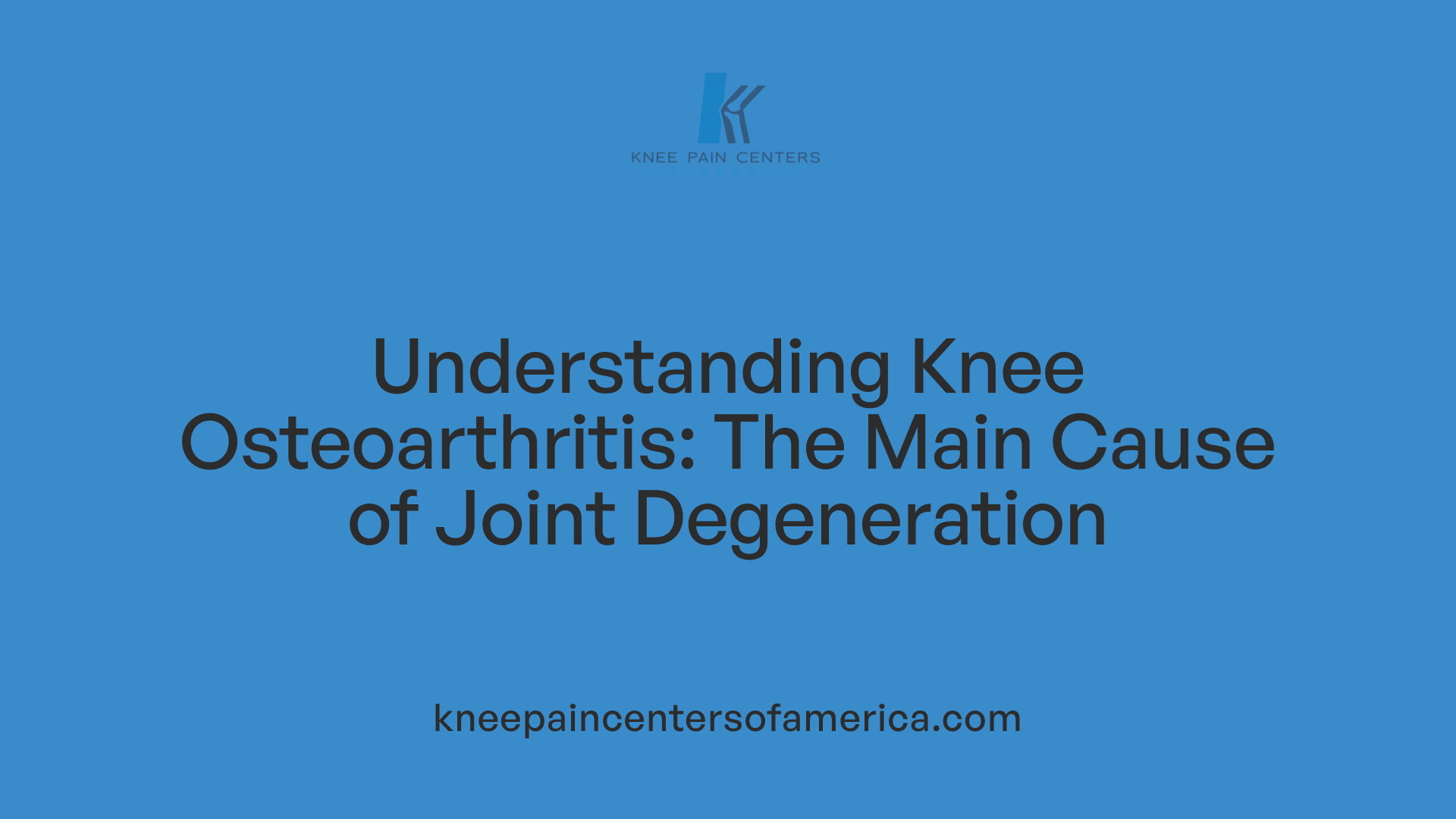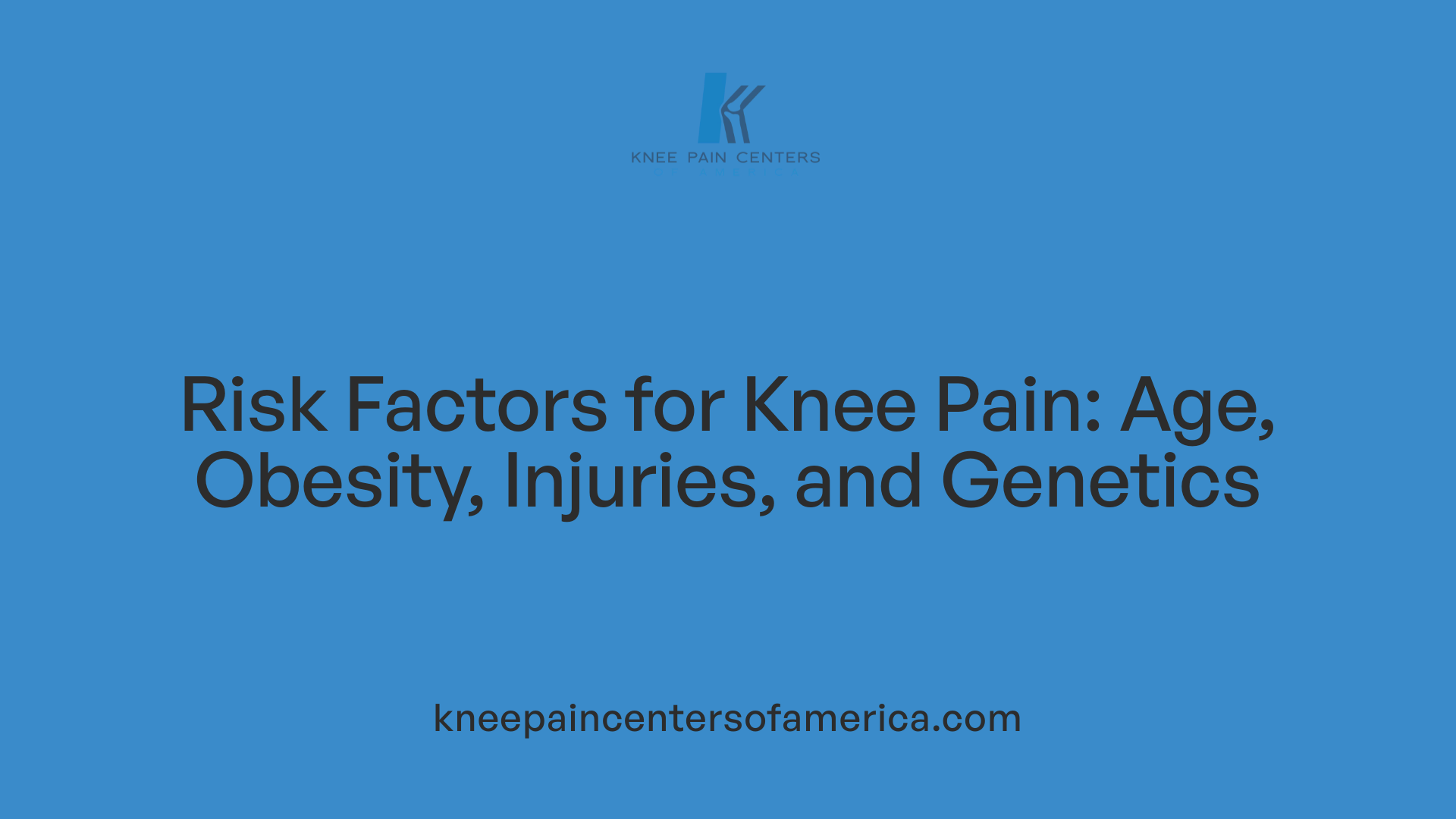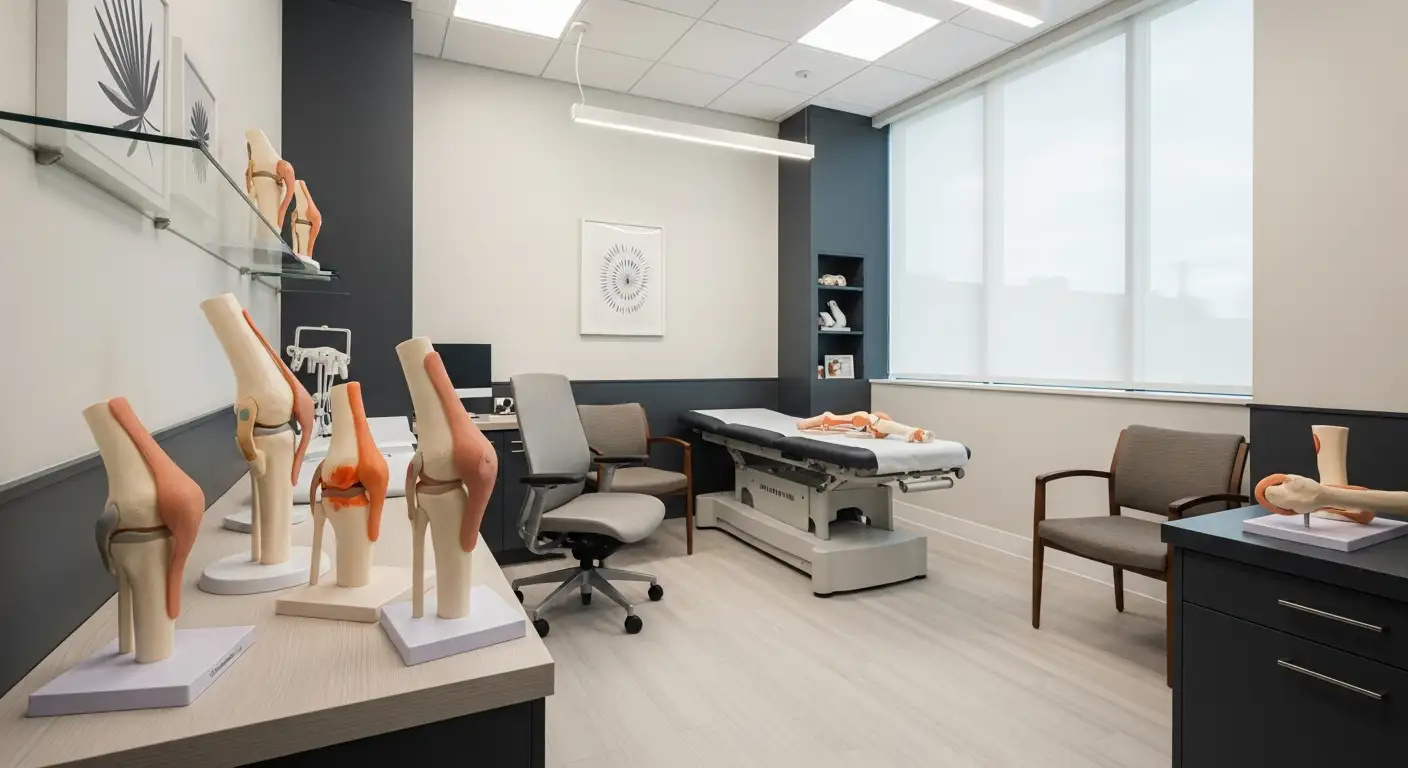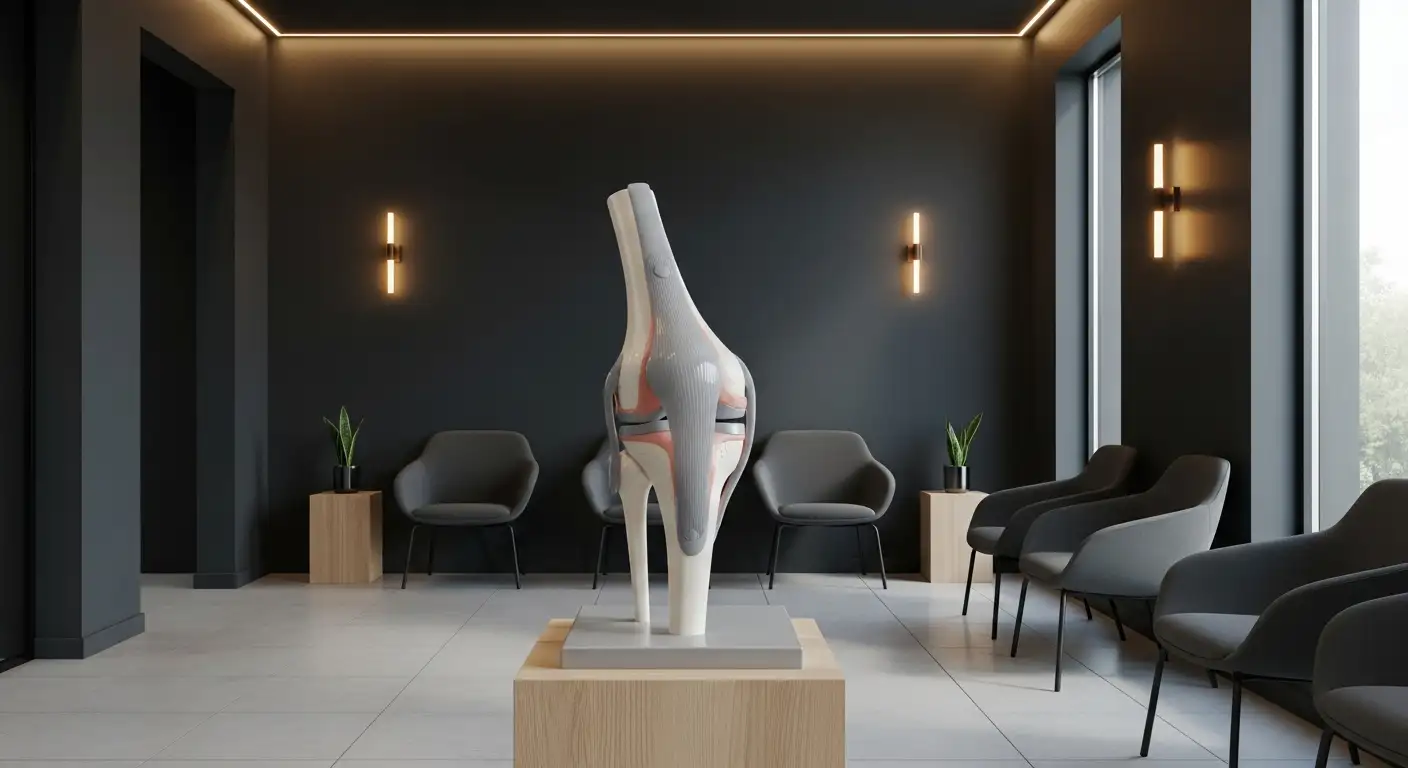Introduction to the Impact of Knee Pain on Mobility
Knee pain is a widespread health challenge affecting millions worldwide and significantly impairs mobility and quality of life, especially in older adults. Osteoarthritis is the most common cause, characterized by gradual cartilage degeneration leading to pain, stiffness, and functional limitations. Addressing knee pain effectively requires a multifaceted approach encompassing education, lifestyle changes, medical treatments, and sometimes surgery. This article explores the critical role knee pain plays in limiting mobility and outlines evidence-based strategies to manage and improve joint function.
Prevalence and Significance of Knee Pain

How common is knee pain and who does it affect?
Knee pain affects approximately one in four adults, making it a widespread health concern. Over the past two decades, the prevalence of knee pain has increased by about 65%, reflecting a growing impact on public health. This rise corresponds with factors such as aging populations and increased rates of obesity.
What is the impact of knee pain on individuals and healthcare systems?
Knee pain leads to significant discomfort and disability, often causing difficulties in walking and daily activities. It accounts for around 4 million primary care visits annually, putting substantial demand on healthcare resources. The condition limits mobility and quality of life, especially in older adults where osteoarthritis is the most common cause.
What are the common causes of knee pain?
The majority of knee pain in adults stems from osteoarthritis (OA), a degenerative joint disease characterized by progressive wear and tear of the knee cartilage. Other common causes include meniscal injuries, repetitive knee stress, prior trauma, anatomical variations, and inflammatory conditions. OA leads to symptoms such as pain, stiffness, swelling, crepitus, and episodes of knee locking or buckling. Risk factors include age over 50, obesity, repetitive knee use, previous injuries, and family history of autoimmune diseases.
Together, these factors underline the importance of recognizing knee pain as a significant and growing health issue that requires effective management strategies.
Understanding Knee Osteoarthritis: The Main Culprit

What is the pathophysiology of osteoarthritis?
Knee osteoarthritis (OA) is a degenerative joint disease characterized by progressive loss of articular cartilage. The cartilage, which cushions the ends of bones in the joint, wears down over time, leading to bone-on-bone contact that causes pain and reduced mobility. This degeneration triggers joint inflammation, bone remodeling—including osteophyte (bone spur) formation—and subchondral sclerosis, which further contribute to symptoms.
How does primary osteoarthritis differ from secondary osteoarthritis?
Osteoarthritis can be classified into two types: primary and secondary. Primary OA develops due to age-related wear and tear without a specific underlying cause, making it the most common type, especially in the elderly. Secondary OA arises from identifiable causes such as previous joint trauma, congenital abnormalities, or systemic conditions like rheumatoid arthritis. Both types share similar pathological features but differ in etiology.
What are the common symptoms and clinical presentations?
Patients with knee osteoarthritis typically report gradual-onset knee pain that worsens with activity and improves with rest. Other symptoms include joint stiffness, especially after periods of inactivity, swelling, crepitus (a grinding or creaking sensation), and difficulty walking. Clinical examination may reveal joint tenderness, reduced range of motion, warmth, and sometimes episodes of locking or buckling. Radiographic findings often show joint space narrowing, osteophyte formation, subchondral cysts, and sclerosis.
Understanding these elements is crucial for recognizing knee osteoarthritis and guiding appropriate management strategies.
Risk Factors Driving Knee Pain and Mobility Issues

Age and Obesity
Age is a significant risk factor for knee osteoarthritis (OA), with the incidence increasing notably in individuals over 50 years old. This progressive condition worsens with age as the articular cartilage deteriorates naturally over time. Obesity compounds this risk by increasing the mechanical load on knee joints. Excess body weight not only accelerates cartilage wear but also elevates inflammation, contributing to pain and mobility restriction. A weight loss of 5%–10% has been shown to significantly reduce knee pain and improve function.
Repetitive Stress and Injury
Mechanical stress from repetitive activities, such as kneeling, squatting, or frequent loading, can damage knee cartilage and surrounding structures, increasing the risk of osteoarthritis and knee pain. Prior knee injuries, including ligament tears or meniscal damage, predispose patients to early joint degeneration. Overuse conditions lead to cartilage breakdown and symptoms like stiffness, swelling, and difficulty walking.
Genetics and Autoimmune Contributors
A family history of autoimmune diseases can increase susceptibility to inflammatory arthritis affecting the knee. Although knee OA is generally degenerative, autoimmune processes may lead to joint inflammation and accelerated cartilage loss in some cases. Genetic predisposition influences the structural integrity of cartilage and joint tissues, thereby modulating individual risk.
| Risk Factor | Impact | Clinical Note |
|---|---|---|
| Age | Progressive cartilage loss with aging | Increases prevalence in adults over 50 years |
| Obesity | Increased joint load and inflammation | Weight loss improves symptoms and delays progression |
| Repetitive Stress | Mechanical cartilage and soft tissue damage | Occupational exposures enhance risk |
| Prior Injury | Early joint degeneration | History of ligament or meniscal tears is common |
| Genetic/Autoimmune | Inflammation and altered cartilage metabolism | Family history of autoimmune diseases adds risk |
Diagnosis: Identifying the Sources of Knee Pain
Physical Examination Techniques
Diagnosing knee pain begins with a thorough physical examination. Physicians inspect the knee for signs such as swelling, tenderness, warmth, or bruising. They also assess the range of motion and test joint stability to detect issues like ligament tears or cartilage damage. Special attention is paid to symptoms like crepitus (joint noises), locking, weakness, and buckling, which can indicate osteoarthritis or other joint problems.
Imaging Modalities Like X-rays and MRI
Imaging plays a crucial role in evaluating knee conditions. X-rays are commonly used to identify structural changes including joint space narrowing, osteophytes, subchondral sclerosis, and cysts, which are indicators of osteoarthritis. When soft tissue injuries or complex joint pathologies are suspected, MRI provides detailed images of cartilage, ligaments, menisci, and surrounding structures. CT scans and ultrasound may also be utilized for specific diagnostic needs such as fractures or soft tissue assessment.
Laboratory Tests for Inflammation or Infection
Laboratory investigations help distinguish inflammatory or infectious causes of knee pain. Blood tests may detect markers of autoimmune diseases such as rheumatoid arthritis or gout. Arthrocentesis, or joint fluid analysis, is performed when infection or crystal-induced arthritis is suspected. This aids in confirming the diagnosis and guiding appropriate treatment.
Effective diagnosis of knee pain relies on combining clinical examination, imaging studies, and laboratory tests to pinpoint the underlying cause and tailor management strategies accordingly.
First-Line Management: Patient Education's Vital Role

Correcting misconceptions about OA
Education plays a crucial role in managing knee osteoarthritis (OA) by dispelling common myths about the disease. Many patients mistakenly believe OA is an incurable, inevitably progressive condition. Patient education programs clarify that while OA has no cure, symptoms can be effectively managed, and disease progression can be slowed. This shift in understanding helps reduce fear and encourages proactive engagement in treatment.
Enhancing self-management and medication adherence
Well-informed patients are better equipped to take control of their health. Education improves self-management by guiding individuals on appropriate lifestyle changes, such as engaging in regular physical activity and maintaining a healthy weight. It also fosters better adherence to prescribed medications and recommended therapies, thereby improving overall treatment outcomes. Studies show that patients who receive comprehensive education are more likely to follow through with exercise regimens and weight loss plans.
Empowering patients through knowledge
Providing clear, accessible information empowers patients to actively participate in their care. Educated patients can communicate more effectively with healthcare providers, ask pertinent questions, and make informed decisions about treatment options. This empowerment improves confidence, promotes consistent symptom monitoring, and helps patients adopt a long-term, collaborative approach to managing their OA symptoms and maintaining joint function.
Exercise Therapy: The Cornerstone of Conservative Treatment

Types of Effective Exercises
Exercise therapy for knee osteoarthritis primarily involves moderate-intensity aerobic activities and muscle-strengthening exercises. Suitable aerobic exercises include walking, cycling, and swimming, which are joint-friendly and improve cardiovascular fitness without undue stress on the knees. Muscle-strengthening exercises focus on key muscle groups around the knee such as the quadriceps, hamstrings, and hip muscles. These exercises help stabilize the joint, reduce pain, and improve overall function.
Benefits of Moderate-Intensity Aerobic and Muscle Strengthening
Engaging in 150 minutes per week of moderate-intensity aerobic exercise or at least two days of muscle-strengthening exercises has been shown to reduce knee pain and enhance joint function. Even as little as 45 minutes a week can provide benefits for lower extremity osteoarthritis. Muscle-strengthening, in particular, alleviates pain by improving muscular support around the knee, reducing joint load and enhancing mobility. Aerobic exercise also aids in weight management, which is critical since weight loss of 5%–10% can significantly lessen symptoms in overweight or obese patients.
Supervised Versus Home Exercise Programs
Supervised exercise programs, typically conducted three times per week under the guidance of physiotherapists, offer greater improvements in pain reduction compared to unsupervised home-based exercises. Supervision ensures correct exercise technique, enhances adherence, and helps tailor intensity to the patient’s condition. However, home exercises remain valuable as they promote long-term self-management and can be integrated easily into daily routines. Combining both supervised and home-based approaches can optimize outcomes for patients with knee osteoarthritis.
Weight Management: Reducing Joint Load and Pain

How Does Obesity Impact Knee Joint Load?
Obesity is a significant risk factor for knee osteoarthritis (OA) because excess body weight increases the mechanical load on the knee joints. This added stress accelerates cartilage wear and contributes to pain and functional decline. Studies show that even small increases in weight can dramatically increase the forces across the knee during daily activities such as walking and climbing stairs.
What Are the Benefits of Losing 5-10% of Body Weight?
Losing between 5% and 10% of body weight has been shown to meaningfully reduce knee pain and improve function in individuals with knee OA. For example, a weight loss of 10% can reduce knee joint loading by approximately 20-30%, which translates into meaningful symptom relief. Additionally, weight loss improves self-reported disability and enhances quality of life.
How Is Weight Loss Related to Pain Relief and Functional Improvement?
Weight loss decreases the load on the knee joint, reducing pain caused by joint degeneration and inflammation. This reduction in pain encourages greater physical activity and facilitates participation in exercise, which further strengthens muscles around the knee and supports joint stability. Improved function includes better mobility, reduced stiffness, and decreased risk of further joint damage. Every 1% loss in body weight corresponds to roughly a 2% reduction in the risk of needing knee replacement surgery.
In summary, weight management is a cornerstone of knee OA treatment. Clinicians strongly recommend weight loss alongside exercise and patient education as first-line interventions, especially for overweight or obese patients, to effectively manage symptoms and improve joint health.
Physical Therapy and Assistive Devices to Enhance Mobility
Role of Strengthening and Flexibility Exercises
Physical therapy is crucial in managing knee osteoarthritis and related knee pain. Strengthening exercises, particularly those targeting the quadriceps, hip muscles, and hamstrings, help improve muscle support around the knee. This support reduces joint stress and pain while enhancing stability and function. Flexibility and range-of-motion exercises preserve cartilage health and increase joint comfort during daily activities. Programs often combine resistance training with stretching to reduce pain and disability, improving overall mobility.
Use of Orthotics, Braces, and Canes
Assistive devices play an important role in offloading stress from painful knee joints. Orthotics, such as arch supports and wedges, can help shift pressure to less affected parts of the knee. Knee braces provide stabilization and may reduce pain, though they are meant to complement—not replace—exercise therapy. Canes offer moderate benefits in pain relief and walking function by improving balance and decreasing joint load. Proper fitting and guidance from healthcare professionals ensure effectiveness and safety.
Correcting Movement Patterns and Improving Stability
Beyond strengthening muscles, physical therapy also focuses on correcting faulty movement patterns that exacerbate knee pain. Techniques include neuromuscular training and gait retraining to improve joint alignment and reduce compensatory stresses. These interventions enhance dynamic stability and balance, lowering the risk of falls and further injury. Tailored exercise programs combined with assistive device use yield the best outcomes in improving knee function and quality of life.
Pharmacological Interventions: Symptom Relief Strategies
Use of topical and oral NSAIDs
Topical nonsteroidal anti-inflammatory drugs (NSAIDs) are strongly recommended as a first-line pharmacological treatment for knee osteoarthritis (OA). They provide effective pain relief and improve joint function with minimal systemic adverse effects, making them a preferred option especially for elderly patients or those at risk for gastrointestinal or cardiovascular complications. Oral NSAIDs are also effective for short-term management of pain but carry a higher risk of side effects, so their use should be carefully monitored, particularly in patients with comorbidities.
Role of acetaminophen and COX-2 inhibitors
Acetaminophen is considered a reasonable initial therapy for knee OA due to its favorable safety profile, especially when NSAIDs are contraindicated or poorly tolerated. However, its effectiveness may be modest compared to NSAIDs. COX-2 inhibitors, a subtype of NSAIDs, offer pain relief with a potentially lower risk of gastrointestinal adverse effects than traditional NSAIDs and may be suitable for patients who require long-term therapy but need to avoid the gastrointestinal complications associated with standard NSAIDs.
Corticosteroid injections and biological treatments
Intra-articular corticosteroid injections are commonly used for their rapid but short-term symptom relief, reducing inflammation and pain during flare-ups of knee OA. These injections are typically reserved for patients with moderate-to-severe symptoms unresponsive to oral medications or physical therapy. Biological treatments, such as platelet-rich plasma (PRP) and viscosupplementation with hyaluronic acid, have been applied with the aim to reduce symptoms and promote joint health. However, evidence supporting their effectiveness is limited and variable, making them less routinely recommended. Opioids are generally discouraged due to limited benefits and a higher risk of adverse effects.
These medication strategies are most effective when integrated with non-pharmacological approaches like patient education, exercise, and weight management, ensuring comprehensive symptom control and improved quality of life for those with knee osteoarthritis.
Limitations and Risks of Opioids and Nutraceuticals
Why Opioids Are Discouraged
Opioids are generally discouraged in the treatment of knee osteoarthritis due to their limited effectiveness in managing pain and a higher risk of adverse effects. These risks include dependency, tolerance, sedation, and potential respiratory depression, which can outweigh the benefits in managing chronic joint pain. Given these concerns, opioids are not recommended as a first-line or even routine treatment option.
Lack of Sufficient Evidence for Glucosamine and Chondroitin
Nutraceuticals such as glucosamine and chondroitin sulfate are commonly used supplements for osteoarthritis. However, high-quality evidence supporting their effectiveness is lacking. Major guidelines and expert panels do not recommend these supplements due to inconsistent results from clinical studies. Their benefit in reducing pain or improving joint function has not been conclusively established.
Patient Guidance on Supplement Use
Patients should be counseled on the limited effectiveness and potential costs associated with glucosamine and chondroitin. It is important to emphasize evidence-based treatments like exercise, weight management, and topical NSAIDs as superior options. Healthcare providers should guide patients to avoid relying on supplements with unclear benefits and focus on safer and more effective management strategies for knee osteoarthritis.
Advanced Non-Pharmacological Therapies and Complementary Treatments
Manual Therapy, Massage, and Taping
Manual therapy, including joint mobilization and patellar mobilization, is often used as an adjunct treatment to improve joint function and reduce pain in knee osteoarthritis (OA). While evidence quality is limited, these approaches may help enhance range of motion and comfort.
Massage therapy may also provide symptomatic relief, offering improvements in pain and physical function by promoting circulation and reducing muscle tension around the knee. Similarly, taping techniques can provide knee stabilization and decrease discomfort, although these should complement rather than replace active rehabilitation exercises.
Use of Modalities Like TENS, Ultrasound, and Shockwave Therapy
Electrophysical agents have gained interest for pain management and functional improvement in knee OA. Transcutaneous Electrical Nerve Stimulation (TENS) delivers low-voltage electrical stimulation to reduce pain signals and is supported by evidence for short-term relief.
Therapeutic ultrasound uses sound waves to promote tissue healing and reduce inflammation, which may help ease symptoms though the evidence is variable. Shockwave therapy, involving high-energy sound waves, shows promise in enhancing pain relief and mobility, with moderate evidence supporting its use.
Other modalities such as pulsed electromagnetic fields, neuromuscular electrical stimulation (NMES), laser therapy, and interferential current may be used based on individual patient needs and availability, though they generally have limited or emerging evidence.
Role of Acupuncture, Tai Chi, and Yoga
Complementary therapies such as acupuncture, Tai Chi, and yoga have been recognized for their benefits in managing knee OA symptoms, particularly when integrated with conventional treatments.
Acupuncture may help reduce pain and improve joint function by stimulating nerves and boosting endorphin release. Tai Chi, a gentle mind-body exercise, enhances muscle strength, flexibility, balance, and reduces fall risk while alleviating stiffness and discomfort.
Yoga promotes flexibility, strength, and relaxation, contributing to improved physical and psychological well-being in OA patients. These practices also support mental health by reducing stress and enhancing coping skills.
Combining these complementary therapies with education, exercise, and weight management can optimize quality of life and symptom control for individuals with knee osteoarthritis.
Surgical Options: Indications and Outcomes
When Is Surgery Considered for Knee Osteoarthritis?
Surgery for knee osteoarthritis (OA) is generally reserved for patients who have not found relief through conservative treatments such as physical therapy, exercise, weight loss, and medication. Surgery is typically considered when symptoms are severe, markedly limiting daily activities and quality of life, or when radiographic imaging shows advanced joint damage with significant cartilage loss and bone changes.
Types of Surgical Interventions
There are several surgical options depending on the severity and location of joint damage:
- Arthroscopy: Minimally invasive surgery to clean out the joint. However, it is generally not recommended for OA due to low effectiveness.
- High Tibial Osteotomy (HTO): This involves realigning the knee joint to redistribute weight away from the damaged area, often chosen for younger, active patients with localized arthritis.
- Unicompartmental Knee Arthroplasty (UKA): Partial knee replacement for cases where arthritis affects only one compartment of the knee.
- Total Knee Arthroplasty (TKA): Complete knee replacement is the most definitive option, used for end-stage OA and severe joint destruction.
Outcomes and Risks
Total Knee Replacement (TKA): This surgery significantly improves pain, function, and quality of life for most patients. However, it comes with risks such as infection, blood clots, and prosthesis wear over time. Long-term success depends on patient factors and surgical technique.
High Tibial Osteotomy (HTO): Can delay the need for knee replacement by offloading stress on damaged parts of the knee, particularly effective in younger patients. Risks include nerve injury, nonunion at the osteotomy site, and less predictable pain relief than arthroplasty.
Given the irreversible progression of knee OA, surgical interventions aim primarily to restore function, reduce pain, and improve patient mobility when nonsurgical therapies have failed. Comprehensive evaluation by an interprofessional healthcare team assists in selecting the most appropriate surgical option tailored to individual patient needs and goals.
Bridging the Gap: The Discrepancy Between Guidelines and Practice
Underutilization of First-Line Treatments
Despite strong evidence supporting the benefits of patient education, physical exercise, and weight maintenance as first-line treatments for knee osteoarthritis (OA), less than 40% of patients actually receive these interventions. This gap highlights a significant disconnect between clinical guidelines and real-world practice, leading to missed opportunities for pain reduction and functional improvement.
Barriers to Implementing Conservative Management
Several factors contribute to this underuse. These include limited patient awareness about non-pharmacological options, inadequate time or resources within clinical settings to provide comprehensive education and supervised exercise programs, and clinician hesitancy due to perceived patient non-compliance or lack of confidence in conservative measures. Furthermore, patients may face challenges such as lack of access to specialized physical therapy or difficulties maintaining weight loss.
Importance of Evidence-Based Clinical Care
Bridging this gap requires prioritizing evidence-based conservative management as the foundation of knee OA treatment. Incorporating structured patient education helps correct misconceptions about OA’s progression and encourages adherence to exercise regimens. High-quality trials demonstrate that supervised exercise sessions significantly reduce pain and improve joint function; weight loss of 5%–10% in overweight individuals further enhances these benefits. Therefore, clinical systems must adopt multidisciplinary approaches and focus on personalized care plans that reflect guideline recommendations to optimize patient outcomes.
Assessing Treatment Effectiveness: Outcome Measures in Knee Pain
What Patient-Reported Outcome Tools Are Used for Knee Osteoarthritis?
Patient-reported outcome measures (PROMs) play a vital role in evaluating the impact of knee osteoarthritis (OA) treatments. Common tools include the Western Ontario and McMaster Universities Arthritis Index (WOMAC), the Knee Injury and Osteoarthritis Outcome Score (KOOS), and the Visual Analog Scale (VAS) for pain.
- WOMAC assesses pain, stiffness, and physical function specifically related to OA.
- KOOS expands on WOMAC by evaluating symptoms, function in daily living, function in sports, and knee-related quality of life.
- VAS allows patients to indicate their current pain intensity on a scale, providing a quick and sensitive gauge of symptom changes.
These instruments empower patients to communicate symptom severity and functional limitations, guiding clinicians in tailoring management and tracking progress over time.
Which Performance-Based Functional Tests Are Common?
Performance-based tests objectively measure functional abilities affected by knee osteoarthritis, complementing patient-reported insights. Key tests include:
- 30-second Chair Stand Test: Measures lower body strength by counting how many stands a patient can complete from a seated position in 30 seconds.
- 6-Minute Walk Test: Assesses endurance and walking ability by recording the distance covered in 6 minutes.
These tests help quantify physical performance and monitor improvements or declines in mobility and strength resulting from treatments like exercise therapy.
Why Is It Important to Monitor Pain and Physical Function?
Monitoring both pain and physical function is essential for comprehensive knee OA care. Pain reduction alone does not necessarily equate to improved joint function; conversely, better function may not always reduce pain immediately.
By using both subjective PROMs and objective performance tests, healthcare professionals can obtain a holistic understanding of treatment effectiveness. This enables adjustments in therapy to optimize patient outcomes, enhance quality of life, and delay disease progression.
Regular assessment facilitates early identification of treatment failure or adverse effects, promoting timely intervention. Ultimately, robust outcome measurement supports evidence-based decision-making and personalized patient care in managing knee osteoarthritis.
The Role of an Interdisciplinary Healthcare Team
Collaboration between Physical Therapists, Dietitians, Physicians
Effective management of knee osteoarthritis (OA) relies heavily on an interdisciplinary healthcare team. This team typically includes physical therapists, dietitians, physicians such as rheumatologists and orthopedic surgeons, pharmacists, and nurses. Each professional contributes their expertise to address distinct aspects of the disease. Physical therapists design and supervise individualized exercise programs to improve joint function and reduce pain. Dietitians provide guidance on weight loss and nutrition, which is crucial since weight reduction significantly decreases joint load and symptoms. Physicians oversee medical management, including pharmacological treatments and the assessment of surgical options.
Comprehensive Care Planning
Comprehensive care planning involves coordinated efforts where all team members collaborate to tailor treatment plans based on the patient's clinical status, lifestyle, and preferences. For instance, exercise therapy is customized and might combine aerobic activities with muscle strengthening to maximize benefit. Nutritional counseling targets a 5–10% weight loss in overweight patients to improve pain and quality of life. Pharmacological strategies and non-pharmacological interventions—such as patient education, braces, and psychosocial support—are integrated judiciously. This holistic approach helps manage symptoms, delay disease progression, and improve overall function.
Benefits of a Multidisciplinary Approach for Patient Outcomes
Patients with knee OA experience markedly improved outcomes when cared for by an interdisciplinary team. Such collaboration enhances adherence to treatment plans, especially in adopting lifestyle modifications like exercise and weight control. Education by healthcare providers dispels misconceptions about the disease, empowering patients in self-management and improving medication compliance. Moreover, the team approach facilitates timely adjustments in therapy and appropriate referrals, which substantially enhance pain relief, joint function, and quality of life. Ultimately, interdisciplinary care exemplifies evidence-based management that targets the multifaceted nature of knee osteoarthritis.
Psychosocial Factors and Their Impact on Knee Pain Management
How do mental health and coping skills affect knee pain management?
Mental health plays a significant role in how individuals manage knee osteoarthritis (OA). Poor mental health, including conditions like depression or anxiety, can exacerbate the perception of pain and limit motivation for self-care activities such as exercise and weight management. Developing effective coping skills empowers patients to better handle chronic pain, reduce stress-related flare-ups, and maintain adherence to treatment plans.
Why is social support important in managing knee osteoarthritis?
Social support from family, friends, and healthcare providers contributes positively to patient outcomes. It encourages adherence to therapeutic exercises, provides emotional reassurance, and helps patients cope with the disease’s challenges. Support groups and community programs also foster shared experiences, which can alleviate feelings of isolation and improve overall well-being.
How are psychosocial interventions integrated into knee OA management?
Psychosocial interventions are used alongside physical and pharmacological treatments to address the emotional and social dimensions of knee OA. These interventions may include counseling, stress management, cognitive-behavioral therapy, and educational programs aimed at improving coping mechanisms. Integrating these approaches ensures a comprehensive treatment plan that targets both physical symptoms and psychological health, improving patients’ quality of life and functional outcomes.
Innovations and Future Directions in Knee Pain Treatment
Emerging Biological Treatments
Recent advances have focused on biological therapies aiming to enhance joint repair and reduce inflammation. Platelet-rich plasma (PRP) injections are gaining attention for their potential to promote healing by delivering concentrated growth factors directly to the damaged tissues. Although current evidence is still evolving, PRP is used adjunctively to reduce pain and improve mobility in knee osteoarthritis (OA).
Technological Advances in Physical Therapy
Technology-enhanced rehabilitation is transforming physical therapy for knee pain. Interactive devices for neuromuscular training and virtual reality platforms provide patient-tailored exercise programs that improve adherence and outcomes. Wearable sensors enable real-time monitoring of joint movements, allowing therapists to adjust exercises precisely, enhancing muscle strength and joint function more effectively.
Potential Upcoming Disease-Modifying Therapies
Unlike symptom-relieving treatments, disease-modifying therapies aim to alter the course of OA by protecting cartilage or promoting regeneration. Current research is exploring biologics such as monoclonal antibodies targeting inflammatory mediators, stem cell therapies, and gene-editing techniques. While no definitive disease-modifying agent is approved yet, these approaches hold promise for future management, potentially slowing progression and improving joint health beyond symptomatic control.
Community and Evidence-Based Physical Activity Programs
Examples such as ACTIVE LIVING EVERY DAY, WALK WITH EASE
Several community-based and evidence-based physical activity programs are available to support individuals with knee osteoarthritis. Programs like ACTIVE LIVING EVERY DAY and WALK WITH EASE provide structured, accessible opportunities for patients to engage in regular physical activity tailored to their needs. Other notable programs include FIT AND STRONG! and ENHANCE FITNESS, which emphasize both aerobic and strengthening exercises.
Benefits of Structured Programs
These programs have been shown to significantly improve pain, stiffness, and physical function in osteoarthritis patients. By offering a guided exercise approach, they help participants safely increase their activity levels, which is crucial for managing symptoms and slowing disease progression. Structured programs also provide education on exercise techniques, promote weight management, and encourage consistent participation, leading to long-term health benefits.
Enhancing Adherence and Social Engagement
One of the advantages of community programs is the social support and engagement they foster among participants. Group sessions offer motivation, accountability, and a sense of camaraderie, which can help improve adherence to exercise routines. The combination of social interaction and professional guidance makes these programs effective in addressing both physical and psychosocial aspects of osteoarthritis management.
Individualized Treatment: Tailoring Care to Patient Needs and Preferences
Importance of personalized plans
Each patient with knee osteoarthritis presents unique clinical features, lifestyle factors, and treatment goals. Creating a personalized care plan is crucial for maximizing treatment effectiveness. Tailored approaches consider individual pain levels, physical function, comorbidities, and patient preferences.
Balancing clinical judgment and evidence
Optimal management balances high-quality evidence with clinical judgment. While strong recommendations exist for patient education, physical exercise, and weight management as first-line treatments, clinicians must adapt these guidelines to suit each patient's specific context. For instance, supervised exercises may benefit some patients more, while others may require modifications due to comorbid conditions or mobility limitations.
Involving patients in decision-making
Shared decision-making empowers patients by involving them actively in their care choices. Educating patients about the progressive yet manageable nature of osteoarthritis dispels misconceptions and enhances adherence. Discussing the benefits and risks of pharmacological treatments, assistive devices, and possible surgical interventions allows patients to weigh options based on their values and lifestyles.
An individualized plan typically includes education on self-management, tailored exercise programs (such as 150 minutes weekly of moderate aerobic activity or strength training), and weight loss strategies when appropriate. Incorporating patient goals and preferences ensures engagement and long-term success in managing symptoms and improving quality of life.
Conclusion: Unlocking Mobility Through Comprehensive Knee Pain Management
Knee pain, predominantly from osteoarthritis, is a major factor limiting mobility and quality of life among millions worldwide. Despite well-established, evidence-based conservative treatments such as patient education, exercise therapy, and weight management, many patients do not receive optimal care. Pharmacological options can help manage symptoms, while surgical interventions remain a last resort. Emphasizing an interdisciplinary, individualized approach that incorporates physical, pharmacological, psychosocial, and complementary therapies offers the best chance to improve function and reduce disability. With continued research and broader implementation of guideline-based strategies, countless individuals suffering from knee pain can regain independence and enhance their daily living.
References
- Knee osteoarthritis: key treatments and implications for ...
- Arthritis in Knee: Signs, Symptoms, Causes & Treatment
- Knee Osteoarthritis - StatPearls
- Knee pain - Diagnosis and treatment
- Knee Arthritis
- Nonpharmacologic - Osteoarthritis Action Alliance
- Nonsurgical Management of Knee Pain in Adults
- Management of Osteoarthritis of the Knee (Non-Arthroplasty)
- Knee Osteoarthritis





